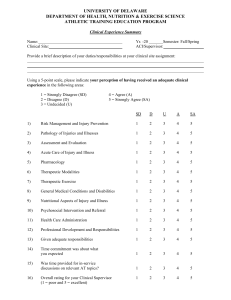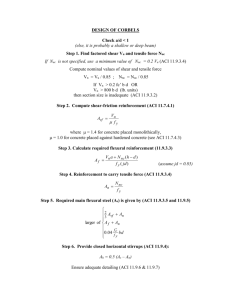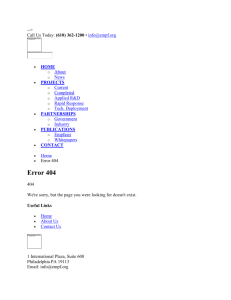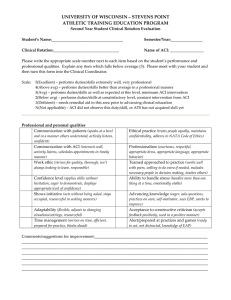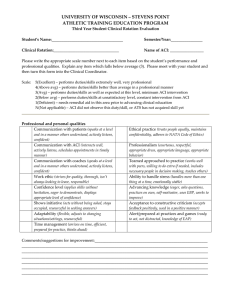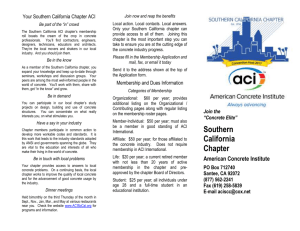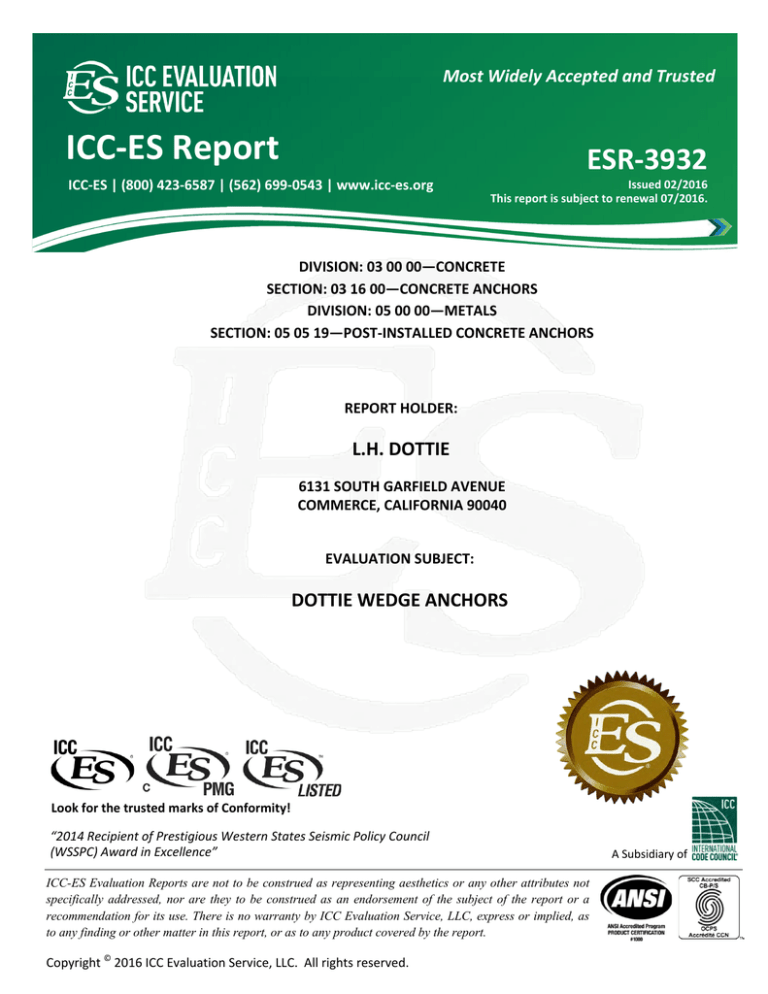
Most Widely Accepted and Trusted
0
ICC-ES Report
ICC-ES | (800) 423-6587 | (562) 699-0543 | www.icc-es.org
000
ESR-3932
Issued 02/2016
This report is subject to renewal 07/2016.
DIVISION: 03 00 00—CONCRETE
SECTION: 03 16 00—CONCRETE ANCHORS
DIVISION: 05 00 00—METALS
SECTION: 05 05 19—POST-INSTALLED CONCRETE ANCHORS
REPORT HOLDER:
L.H. DOTTIE
6131 SOUTH GARFIELD AVENUE
COMMERCE, CALIFORNIA 90040
EVALUATION SUBJECT:
DOTTIE WEDGE ANCHORS
Look for the trusted marks of Conformity!
“2014 Recipient of Prestigious Western States Seismic Policy Council
(WSSPC) Award in Excellence”
ICC-ES Evaluation Reports are not to be construed as representing aesthetics or any other attributes not
specifically addressed, nor are they to be construed as an endorsement of the subject of the report or a
recommendation for its use. There is no warranty by ICC Evaluation Service, LLC, express or implied, as
to any finding or other matter in this report, or as to any product covered by the report.
Copyright © 2016 ICC Evaluation Service, LLC. All rights reserved.
A Subsidiary of
ESR-3932
ICC-ES Evaluation Report
Issued February 2016
This report is subject to renewal July 2016.
www.icc-es.org | (800) 423-6587 | (562) 699-0543
DIVISION: 03 00 00—CONCRETE
Section: 03 16 00—Concrete Anchors
DIVISION: 05 00 00—METALS
Section: 05 05 19—Post-Installed Concrete Anchors
REPORT HOLDER:
L.H. DOTTIE COMPANY
6131 SOUTH GARFIELD AVENUE
COMMERCE, CALIFORNIA 90040
(323) 725-1000
www.lhdottie.com
lane@lhdottie.com
EVALUATION SUBJECT:
DOTTIE WEDGE ANCHORS
1.0 EVALUATION SCOPE
Compliance with the following codes:
2015, 2012, 2009 and 2006 International Building
®
Code (IBC)
2015, 2012, 2009 and 2006 International Residential
®
Code (IRC)
A Subsidiary of the International Code Council ®
3.0 DESCRIPTION
3.1 Dottie Wedge Anchors:
The Dottie Wedge Anchors are torque-controlled
expansion anchors. The anchors consist of a stud, nut,
washer and expander collar (clip) as illustrated in Figure 1
of this report. The stud for all sizes is manufactured
from cold-drawn carbon steel meeting the requirements
of Chinese Standard Q/HGJ2184, Grade SWRCH35K or
equivalent with a minimum ultimate tensile strength of
79,750 psi (550 MPa) and is partially threaded with one
end terminating in a flared mandrel. The expander collar
(clip) is manufactured from hot-rolled carbon steel meeting
the requirements of Chinese Standard GB/T8749 with a
minimum ultimate tensile strength of 79,750 psi (550 MPa)
and is formed around the stud mandrel so it is able to
move freely. All components, including nuts and washers,
are coated in accordance with ASTM B633 Classification
SC1, Type III. Installation information and dimensions are
set forth in Section 4.3, Figure 2, and Table 1 and Table 2
of this report.
3.2 Concrete:
Normal-weight and lightweight concrete must comply with
Sections 1903 and 1905 of the IBC, as applicable.
4.0 DESIGN AND INSTALLATION
Property evaluated:
4.1 Strength Design:
Structural
4.1.1 General: Design strength of anchors complying with
2015 IBC, as well as Section R301.1.3 of the 2015 IRC
must be determined in accordance with ACI 318-14 and
this report.
2.0 USES
Dottie Wedge Anchors are used to resist static, wind, and
earthquake tension and shear loads in normal-weight
concrete and lightweight concrete having a specified
compressive strength, f′c, of 2,500 psi to 8,500 psi
(17.2 MPa to 58.6 MPa). The ¼-inch (3.4 mm) nominal
diameter anchor is for use in uncracked concrete
applications (Seismic Design Categories A and B only); the
3
/8-inch (9.5 mm) and ½-inch (12.7 mm) nominal diameter
anchors are for use in uncracked and cracked concrete
(Seismic Design Categories A through F).
Dottie Wedge Anchors comply with Section 1901.3 of
2015 IBC, Section 1909 of the 2012 IBC, and Section 1912
of the 2009 and 2006 IBC. The anchors are alternatives to
cast-in-place anchors described in Section 1908 of the
2012 IBC and Section 1911 of the 2009 and 2006 IBC. The
anchors may also be used under the IRC where an
engineered design is submitted in accordance with Section
R301.1.3.
Design strength of anchors complying with the 2012 IBC,
as well as Section R301.1.3 of the 2012 IRC, must be
determined in accordance with ACI 318-11 Appendix D
and this report.
Design strength of anchors complying with the 2009 IBC,
as well as Section R301.1.3 of the 2009 IRC, must be
determined in accordance with ACI 318-08 Appendix D
and this report.
Design strength of anchors complying with the 2006 IBC
and Section R301.1.3 of the 2006 IRC must be determined
in accordance with ACI 318-05 Appendix D and this report.
The strength design of anchors must comply with
ACI 318-14 17.3.1 or ACI 318 (-11, -08, -05) D.4.1, as
applicable. Strength reduction factors, , as given in ACI
318-14 17.3.3 or ACI 318-11 D.4.3 or ACI 318 (-08, -05)
D.4.4, as applicable, must be used for load combinations
ICC-ES Evaluation Reports are not to be construed as representing aesthetics or any other attributes not specifically addressed, nor are they to be construed
as an endorsement of the subject of the report or a recommendation for its use. There is no warranty by ICC Evaluation Service, LLC, express or implied, as
to any finding or other matter in this report, or as to any product covered by the report.
1000
Copyright © 2016 ICC Evaluation Service, LLC. All rights reserved.
Page 1 of 6
ESR-3932 | Most Widely Accepted and Trusted
Page 2 of 6
calculated in accordance with Section 1605.2 of the IBC,
Section 5.3 of ACI 318-14 and Section 9.2 of ACI 318
(-11, -08, -05), as applicable. Strength reduction factors, ,
given in ACI 318-11 D.4.4 or ACI 318 (-08, -05) D.4.5 must
be used for load combinations calculated in accordance
with ACI 318 (-11, -08, -05), Appendix C. The value of f′c,
used in calculations must be limited to a maximum of
8,000 psi (55.2 MPa), in accordance with ACI 318-14
17.2.7 or ACI 318-11 D.3.7, as applicable.
4.1.2 Requirements for Static Steel Strength in
Tension, Nsa: The nominal steel strength of a single
anchor in tension, Nsa, calculated in accordance with
ACI 318-14 17.4.1.2 or ACI 318 (-11, -08, -05) D.5.1.2, as
applicable, must be calculated based on the information
given in Table 1 and must be used for design. The strength
reduction factor, , corresponding to a ductile steel
element may be used.
4.1.3 Requirements for Static Concrete Breakout
Strength in Tension, Ncb or Ncbg: The nominal concrete
breakout strength of a single anchor or a group of anchors
in tension, Ncb and Ncbg, respectively, must be calculated
in accordance with ACI 318-14 17.4.2 or ACI 318
(-11, -08, -05) D.5.2, as applicable, with modifications as
described in this section. The basic concrete breakout
strength in tension, Nb, must be calculated in accordance
with ACI 318-14 17.4.2.2 or ACI 318 (-11, -08, -05)
D.5.2.2, as applicable, using the values of hef and kcr as
given in Table 1 of this report. The nominal concrete
breakout strength in tension in regions of concrete where
analysis indicates no cracking at service loads in
accordance with ACI 318-14 17.4.2.6 or ACI 318 (-11, -08,
-05) D.5.2.6, as applicable, must be calculated with the
value of kuncr given in Table 1 of this report, and with
Ψc,N = 1.0. The value of f′c used in the calculations must be
limited to 8,000 psi (55.2 MPa), in accordance with ACI
318-14 17.2.7 or ACI 318-11 D.3.7, as applicable.
4.1.4 Requirements for Pullout Strength in Tension,
Npn: The nominal pullout strength of a single anchor in
tension in accordance with ACI 318-14 17.4.3 or ACI 318
(-11, -08, -05) D.5.3, as applicable, in cracked and
uncracked concrete, Np,cr and Np,uncr respectively, is given
in Table 1. In lieu of ACI 318-14 17.4.3.6 or ACI 318
(-11, -08, -05) D.5.3.6, as applicable, ψc.P = 1.0 for all
design cases. In accordance with ACI 318-14 17.4.3 or
ACI 318 (-11, -08, -05) D.5.3, as applicable, the nominal
pullout strength in cracked and uncracked concrete may be
calculated in accordance with the Eq-1 or Eq-2
respectively:
,
,
,
,
,
,
,
,
(lb, psi)
,
(Eq-1)
(N, MPa)
.
(lb, psi)
,
.
(Eq-2)
(N, MPa)
Where values for Np,cr and Np,uncr are not provided in
Table 1, the pullout strength in tension need not be
evaluated.
4.1.5 Requirements for Static Steel Strength in shear,
Vsa: The nominal steel strength in shear, Vsa, of a single
anchor in accordance with ACI 318-14 17.5.1.2 or ACI 318
(-11, -08, -05) D.6.1.2, as applicable, is given in Table 1 of
this report, and must be used in lieu of values derived by
calculation from ACI 318-14 Eq. 17.5.1.2a or ACI 318-11
Eq. D-29, as applicable. The strength reduction factor, ,
corresponding to a ductile steel element may be used.
4.1.6 Requirements for Static Concrete Breakout
Strength in Shear, Vcb or Vcbg: The nominal concrete
breakout strength of a single anchor or group of anchors in
shear, Vcb or Vcbg, respectively, must be calculated in
accordance with ACI 318-14 17.5.2 or ACI 318 (-11, -08,
-05) D.6.2, as applicable with modifications as described in
this section. The basic concrete breakout strength in shear,
Vb, must be calculated in accordance with ACI 318-14
17.5.2.2 or ACI 318 (-11, -08, -05) D.6.2.2, as applicable,
using the values of le and da according to Table 1 of this
report. The value of f’c must be limited to a maximum of
8,000 psi (55.2 MPa) in accordance with ACI 318-14
17.2.7 or ACI 318-11 D.3.7, as applicable.
4.1.7 Requirements for Static Concrete Pryout
Strength of Anchor in Shear, Vcp or Vcpg: The nominal
concrete pryout strength of a single anchor or group of
anchors, Vcp or Vcpg, respectively, must be calculated
in accordance with ACI 318-14 17.5.3 or ACI 318
(-11, -08, -05) D.6.3, as applicable, based on the value of
kcp provided in Table 1 and the value of Ncb or Ncbg as
calculated in Section 4.1.3 of this report.
4.1.8 Requirements for Seismic Design:
4.1.8.1 General: For load combinations including seismic,
the design must be performed in accordance with ACI
318-14 17.2.3 or ACI 318-11 D.3.3, as applicable.
Modifications to ACI 318-14 17.2.3 shall be applied under
Section 1905.1.8 of the 2015 IBC. For the 2012 IBC,
Section 1905.1.9 shall be omitted. Modifications to ACI
318-08 and 318-05 D.3.3 shall be applied under Section
1908.1.9 of the 2009 IBC, Section 1908.1.16 of the 2006
IBC, respectively.
The ¼-inch (3.4 mm) anchors are for use in uncracked
concrete applications (Seismic Design Categories A and B
only); the 3/8-inch (9.5 mm) and ½-inch (12.7 mm) anchors
are for use in uncracked and cracked concrete (Seismic
Design Categories A through F). The anchors comply with
ACI 318-14 2.3 or ACI 318-11 D.1, as applicable, as
ductile steel elements. The anchors must be designed in
accordance with ACI 318-14 17.2.3.4, 17.2.3.5, or 17.2.3.6
or ACI 318-11 D.3.3.4, D.3.3.5, or D.3.3.6 or ACI 318-08
D.3.3.4, D.3.3.5 or D.3.3.6, or ACI 318-05 D.3.3.4 or
D.3.3.5, as applicable, with the modifications noted above.
4.1.8.2 Seismic Tension: The nominal steel strength and
concrete breakout strength in tension must be calculated in
accordance with ACI 318-14 17.4.1 and 17.4.2 or ACI 31811 D.5.1 and D.5.2, as applicable, as described in Sections
4.1.2 and 4.1.3 of this report. In accordance with ACI 31814 17.4.3.2 or ACI 318-11 D.5.3.2, as applicable, the
appropriate value for nominal pullout strength in tension for
seismic loads, Np,eq described in Table 1 of this report must
be used in lieu of Np. The values of Np,eq can be adjusted
for concrete strength according to Section 4.1.4 Eq-1 of
this report.
4.1.8.3 Seismic Shear: The nominal concrete breakout
and concrete pryout strength in shear must be calculated
in accordance with ACI 318-14 17.5.2 and 17.5.3 or ACI
318-11 D.6.2 and D.6.3, as applicable, as described in
Sections 4.1.6 and 4.1.7 of this report. In accordance with
ACI 318-14 17.5.1.2 or ACI 318-11 D.6.1.2, as applicable,
the appropriate value for nominal steel strength in shear for
ESR-3932 | Most Widely Accepted and Trusted
Page 3 of 6
accordance with ACI 318-14 Chapter 17
and 2015 IBC Section 1905.1.8, ACI
318-11 Appendix D, ACI 318-08 Appendix
D and 2009 IBC Section 1908.1.9, ACI
318-05 Appendix D and 2006 IBC Section
1908.1.16, and Section 4.1 of this report
as applicable. (lbf or kN).
seismic loads, Vsa,eq described in Table 1 of this report,
must be used in lieu of Vsa.
4.1.9 Requirements for Interaction of Tensile and
Shear Forces: For loadings that include combined tensile
and shear forces, the design must be determined
in accordance with ACI 318-14 17.6 or ACI 318
(-11, -08, -05) D.7, as applicable.
4.1.10 Requirements for Critical Edge Distance: In
applications where the installed edge distance c < cac and
supplemental reinforcement to control splitting of the
concrete is not present, the concrete breakout strength for
the anchors loaded in tension for uncracked concrete,
calculated in accordance with ACI 318-14 17.4.2 or
ACI 318 (-11, -08, -05) D.5.2, as applicable, must be
further multiplied by the factor ΨCP,N as given by the
following equation:
ψcp,N =
c
cac
where the factor ΨCP,N need not be taken as less than
1.5hef /cac.
For all other cases, ΨCP,N = 1.0. In lieu of ACI 318-14
17.7.6 or ACI 318-11 D.8.6, as applicable, values of cac
provided in Table 1 of this report must be used. In all
cases, c must not be less than cmin described in Table 1 of
this report.
4.1.11 Requirements for Minimum Member Thickness,
Minimum Anchor Spacing and Minimum Edge
Distance: In lieu of using ACI 318-14 17.7.1 and 17.7.3 or
ACI 318 (-11, -08, -05) D.8.1 and D.8.3, as applicable,
values of smin and cmin as given in Table 1 of this report
must be used. In lieu of using ACI 318-14 17.7.5 or ACI
318 (-11 -08, -05) D.8.5, as applicable, minimum member
thicknesses hmin as given in Table 1 of this report must be
used.
4.1.12 Lightweight Concrete: For the use of anchors in
lightweight concrete, the modification factor λa equal to
0.8λ is applied to all values of
f c
affecting Nn and Vn.
For ACI 318-14 (2015 IBC), ACI 318-11 (2012 IBC) and
ACI 318-08 (2009 IBC), λ shall be determined in
accordance with the corresponding version of ACI 318.
For ACI 318-05 (2006 IBC), λ shall be taken as 0.75 for
all lightweight concrete and 0.85 for sand-lightweight
concrete. Linear interpolation shall be permitted if partial
sand replacement is used. In addition, the pullout strengths
Np,cr, Np,uncr, and Neq shall be multiplied by the modification
factor, λa, as applicable.
4.2 Allowable Stress Design (ASD):
4.2.1 General: Design values for use with allowable
stress design load combinations, calculated in accordance
with Section 1605.3 of the IBC, must be established in
accordance with the following equations:
Tallowable,ASD =
ϕNn
Vallowable,ASD =
ϕVn
α
α
where:
Tallowable,ASD
= Allowable tension load (lbf or kN)
Vallowable,ASD
= Allowable shear load (lbf or kN)
Nn
= Lowest design strength of an anchor or
anchor group in tension as determined in
Vn
= Lowest design strength of an anchor or
anchor group in shear as determined in
accordance with ACI 318-14 Chapter 17
and 2015 IBC Section 1905.1.8, ACI
318-11 Appendix D, ACI 318-08 Appendix
D and 2009 IBC Section 1908.1.9, ACI
318-05 Appendix D and 2006 IBC Section
1908.1.16, and Section 4.1 of this report
as applicable. (lbf or kN).
α
= Conversion factor calculated as a
weighted average of the load factors for
the controlling load combination. In
addition, α must include all applicable
factors to account for nonductile failure
modes and required over-strength.
The requirements for member thickness, edge distance
and spacing, described in this report, must apply. An
example of allowable stress design values for illustrative
purposes is provided in Table 3 of this report.
4.2.2 Interaction of Tensile and Shear Forces: The
interaction must be calculated and consistent with ACI
318-14 17.6 or ACI 318 (-11, -08, -05) D.7, as applicable,
as follows:
For shear loads Vapplied ≤ 0.2Vallowable,ASD, the full allowable
load in tension must be permitted.
For tension loads Tapplied ≤ 0.2Tallowable,ASD, the full allowable
load in shear must be permitted.
For all other cases the following equation applies:
Tapplied
Vapplied
+
≤1.2
Tallowable,ASD Vallowable,ASD
4.3 Installation:
Embedment, spacing, edge distance, and concrete
requirements must comply with Table 1 and Figure 2.
Anchor locations must comply with this report and the
plans and specifications approved by the code official.
Dottie Wedge Anchors must be installed in accordance
with the manufacturer’s published instructions and this
report (see installation instructions at the end of this
report). In case of conflict, this report governs.
4.4 Special Inspection:
Periodic special inspection is required in accordance with
Section 1705.1.1 and Table 1705.3 of the 2015 IBC and
2012 IBC, Section 1704.15 and Table 1704.4 of the 2009
IBC, or Section 1704.13 of the 2006 IBC, as applicable.
The special inspector must make periodic inspections
during anchor installation to verify anchor type, anchor
dimensions, concrete type, concrete compressive strength,
drill bit type, hole dimensions, hole cleaning procedure,
concrete member thickness, anchor embedment, anchor
spacing, edge distances, tightening torque and adherence
to the manufacturer’s printed installation instructions. The
special inspector must be present as often as required in
accordance with the “statement of special inspection.”
E
ESR-3932 | Most
M
Widely Acc
cepted and Tru
usted
5
5.0 CONDITIO
ONS OF USE
The Dottie Wedge Anchors described in th
his report comp
ply
with, or are suitable altern
natives to what is specified in,
those codes listed in Sectio
on 1.0 of this report,
r
subject to
c
the following conditions:
5.1 The anc
chors are insttalled in acco
ordance with the
t
manufac
cturer’s publish
hed instructions
s and this repo
ort.
In case of
o a conflict, thiis report governs.
5.2 The anc
chors are insta
alled in normal-weight concre
ete
or ligh
htweight concrete having
g a specifiied
compres
ssive strength f′c = 2,500 psi
p to 8,500 psi
p
(17.2 MP
Pa to 58.6 MPa
a).
5.3 Anchor sizes, dimen
nsions, minimum embedme
ent
meters are as set
s
depths, and other insttallation param
forth in this report.
ues of f′c used for calculation
n purposes mu
ust
5.4 The valu
not exce
eed 8,000 psi (5
55.1 MPa).
5.5 Strength
h design valu
ues must be established in
accordan
nce with Sectio
on 4.1 of this re
eport.
5.6 Allowable stress design
n values must be established
d in
accordan
nce with Sectio
on 4.2.
5.7 Anchor spacing(s) an
nd edge dista
ance(s) as well
w
mum memberr thickness must comply with
w
as minim
Table 1.
5.8 Prior to installation
n, calculations and deta
ails
demonsttrating complia
ance with this report must be
submitte
ed to the code
e official. The calculations and
a
details must
m
be prep
pared by a re
egistered desiign
professio
onal where re
equired by the
e statutes of the
t
jurisdictio
on in which the
e project is to be
b constructed.
5.9 Since an
n ICC-ES acc
ceptance criterria for evaluatiing
data to determine the
t
performan
nce of ancho
ors
subjecte
ed to fatigue or shock loading is unavailable
e at
this time
e, the use of
o these anch
hors under su
uch
condition
ns is beyond th
he scope of this
s report.
5.10 The use
e of the ¼-in
nch (3.4 mm) Dottie Wed
dge
Anchors is limited to in
nstallation in un
ncracked norm
malo lightweight concrete.
c
The 3/8-inch (9.5 mm)
weight or
FIGURE 1—
—DOTTIE WEDGE ANCHOR COMPONENTS
P
Page 4 of 6
a
and ½-inch (12.7 mm) anchors may be
e installed
iin cracked or u
uncracked normal weight or lightweight
cconcrete.
5.11 T
The ¼-inch (3.4 mm) anchors may be use
ed to resist
sshort-term loa
ading due to wind or seism
mic forces
llimited to stru
uctures assign
ned to Seism
mic Design
C
Categories A and B under the IBC, subjject to the
cconditions of th
his report.
5.12 W
Where not oth
herwise prohib
bited in the co
ode, Dottie
W
Wedge Ancho
ors are permitted for use with firerresistance-rate
ed construction
n provided tha
at at least
o
one of the follo
owing condition
ns is fulfilled:
The anchorss are used to re
esist wind force
es only.
Anchors th
hat support a fire-resisttance-rated
envelope o
or a fire-resistance-rated membrane
are protectted by approvved fire-resisttance-rated
materials, or have been evvaluated for re
esistance to
ure in accord
fire exposu
dance with recognized
standards.
Anchors a
are
elements.
used
to
support
onstructural
no
5.13 U
Use of the ancchors is limited to dry, interior locations.
5.14 S
Special inspecction must be provided as sset forth in
S
Section 4.4 of tthis report.
5.15 D
Dottie Wedge are produced in Yuyao, Chin
na, under a
q
quality-control program with inspections by ICC-ES.
6.0 EV
VIDENCE SUB
BMITTED
Data in accordance
e with the ICC
C-ES Acceptan
nce Criteria
for M
Mechanical Ancchors in Conccrete Elementss (AC193),
dated
d October 2015
5; and quality-ccontrol docume
entation.
7.0 ID
DENTIFICATIO
ON
Ancho
ors are packkaged in containers labeled
d with the
comp
pany logo and name, producct name, ancho
or size and
length
h, catalog num
mber and the e
evaluation repo
ort number
(ESR
R-3932).
FIGURE 2—DO
OTTIE WEDGE A
ANCHOR INSTA
ALLATION
ESR-3932 | Most Widely Accepted and Trusted
Page 5 of 6
TABLE 1—DATA FOR DOTTIE WEDGE ANCHORS FOR USE IN CONCRETE
CHARACTERISTIC
SYMBOL
UNITS
1, 2
Nominal Anchor Diameter
1
/4 inch
3
/8 inch
1
/2 inch
Installation Information
3
Anchor diameter
da (do)
in.
1
/4
3
/8
1
/2
Minimum diameter of hole clearance in fixture
dh
in.
5
/16
7
/16
9
Nominal drill bit diameter
dbit
in.
1
3
1
/4
3
/8
1
/16
/2
1
Minimum nominal embedment depth
hnom
in.
1 /4
2 /2
2 /2
Minimum effective embedment depth
hef
in.
1 /2
1
2 /4
1
2 /4
2
3
2 /4
2 /4
Minimum hole depth
1
3
ho
in.
Installation torque
Tinst
ft-lb
8
25
35
Minimum edge distance
cmin
in.
1 /4
3
3
6
Minimum spacing
smin
in.
3
5
6
Minimum concrete thickness
hmin
in.
4
4
6
cac
in.
3
6
8
1
1
1
Critical edge distance
Anchor Design Data
Category number
1, 2 or 3
–
Yield strength of anchor steel
fya
lb/in
2
Ultimate strength of anchor steel
futa
lb/in
2
91,700
91,200
88,600
103,100
102,600
99,700
Tension
Effective tensile stress area (neck)
Steel strength in tension
Reduction factor for steel failure modes
in
2
0.022
0.053
0.101
Nsa
lb.
2270
5440
10070
–
kcr
–
–
17
17
kuncr
–
24
24
24
5
Effectiveness factor for concrete breakout, cracked
Effectiveness factor for concrete breakout, uncracked
Reduction factor for concrete breakout
Ase,N
-
Np,uncr
lb.
6
Characteristic pull-out resistance, uncracked concrete
4
0.75
0.65 (Condition B)
1190
2940
N/A
8
Characteristic pull-out resistance, cracked concrete
Np,cr
lb.
-
1330
1080
Characteristic pull-out resistance, seismic loads
Np,eq
lb.
-
1330
1080
Reduction factor for pull-out
-
β
lb/in
Ase,V
in
6
Axial stiffness in service load range
0.65 (Condition B)
147,100
36,500
40,300
2
0.022
0.053
0.101
le
in.
1 1/2
2 1/4
2 1/4
Shear
Effective shear stress area (threads)
Load-bearing length of anchor
Reduction factor for concrete breakout or pryout
6
Coefficient for pryout strength
Steel strength in shear, non-seismic applications
Steel strength in shear, seismic applications
Reduction factor for steel failure
2
5
-4
7
7
-
kcp
-
Vsa
lb.
1050
1830
3610
Vsa,eq
lb.
-
1650
3250
-
0.70 (Condition B)
1.0
0.065
2
For SI: 1 in = 25.4 mm, 1 in = 6.451×10 m, 1 ft-lb = 1.356 Nm, 1 lb/in = 6.895 Pa.
1
The information presented in this table must be used in conjunction with the design criteria of ACI 318-14 Chapter 17 or ACI 318
Appendix D, as applicable.
2
Installation must comply with the manufacturer’s published installation instructions
3
The notation in parentheses is for the 2006 IBC.
4
See Section 4.1.4 of this report.
5
Anchors are considered to be manufactured using ductile steel in accordance with ACI 318-14 2.3 or ACI 318-11 D.1. Strength
reduction factors are for use with the load combinations of ACI 318-14 Section 5.3, ACI 318 (-11, -08, -05) Section 9.2 or IBC Section
1605.2, as applicable.
6
Condition B applies where supplementary reinforcement in conformance with ACI 318-14 17.3.3 or ACI 318 (-11, 08, 05) D.4.3 or ACI
318 (-08, -05) D.4.4 is not provided, or where pull-out or pry-out strength governs. For cases where supplementary reinforcement can
be verified, the strength reduction factors associated with Condition A may be used. Strength reduction factors are for use with the load
combinations of ACI 318-14 Section 5.3, ACI 318-11 Section 9.2 or IBC Section 1605.2.
7
Tabulated values must be used for design since these values are lower than those calculated with ACI 318-14 Eq. (17.5.1.2b), ACI
318-11 Eq. (D-29) or ACI 318-08 and ACI 318-05 Eq. (D-20), as applicable.
8
N/A denotes that pullout resistance is not applicable and does not need to be considered
ESR-3932 | Most Widely Accepted and Trusted
Page 6 of 6
TABLE 2—DOTTIE WEDGE ANCHOR LENGTH CODE IDENTIFICATION SYSTEM
Length ID marking on
threaded stud head
A
B
C
D
E
F
G
H
I
J
K
L
M
N
O
P
Q
1
1
1
1
1
1
1
1
1
Overall
From
1 /2
2
2 /2
3
3 /2
4
4 /2
5
5 /2
6
6 /2
7
7 /2
8
8 /2
9
9 /2
anchor
length,
Up to but not
1
1
1
1
1
1
1
1
2
2 /2
3
3 /2
4
4 /2
5
5 /2
6
6 /2
7
7 /2
8
8 /2
9
9 /2 10
lanch,
including
(inches)
For SI: 1 inch = 25.4 mm.
R
S
10
11
11
12
INSTALLATION INSTRUCTIONS
1. Use a rotary hammer drill in the percussion mode with the correct size carbide drill bit meeting the requirements of ANSI
Standard B212-15 to drill the hole perpendicular to the concrete surface and to the required depth.
2. Use a hand pump, compressed air or vacuum to remove debris and dust from the drilling operation.
3. If installation is through a fixture, position the fixture over the hole and install the anchor through the hole in the fixture.
Using a hammer drive the anchor into the hole insuring that it is installed to the minimum required embedment depth, hnom.
4. Install the washer and nut on the projecting thread and tighten the nut to the required installation torque value, Tinst, using a
torque wrench.
TABLE 3—EXAMPLE OF ALLOWABLE STRESS DESIGN VALUES FOR ILLUSTRATIVE PURPOSES
Nominal Anchor
Diameter, da (do) (in.)
Effective Embedment
Depth, hef (in.)
Allowable Tension
Load, (lbs.)
1
1 /4
3
1 /2
1
520
3
1
2 /2
2 /4
1
1290
1
2 /2
1
2 /4
1
1780
/4
/8
/2
1
Nominal Embedment
Depth, hnom (in.)
1, 2, 3, 4, 5, 6, 7, 8
Single anchor with static tension only.
Concrete determined to remain uncracked for the life of the anchorage
Load combinations from ACI 318-14 Section 5.3 or ACI 318 (-11, -08, 05) Section. 9.2, as applicable and
strength reduction factors from ACI 318-14 17.3.3(c) or ACI 318-11 D.4.3(c) Condition B (supplementary
reinforcement not provided).
4
Controlling load combination 30% dead and 70% live loads, 1.2D+1.6L.
5
Calculation of weighted average α =1.2(0.3) + 1.6(0.7) = 1.48.
6
Normal weight concrete with f'c = 2,500 psi.
7
ca1 = ca2 ≥ cac.
8
h ≥ hmin.
2
3
ICC-ES Evaluation Report
ESR-3932 FBC Supplement
Issued February 2016
This report is subject to renewal July 2016.
www.icc-es.org | (800) 423-6587 | (562) 699-0543
A Subsidiary of the International Code Council ®
DIVISION: 03 00 00—CONCRETE
Section: 03 16 00—Concrete Anchors
DIVISION: 05 00 00—METALS
Section: 05 05 19—Post-Installed Concrete Anchors
REPORT HOLDER:
L.H. DOTTIE COMPANY
6131 SOUTH GARFIELD AVENUE
COMMERCE, CALIFORNIA 90040
(323) 725-1000
www.lhdottie.com
lane@lhdottie.com
EVALUATION SUBJECT:
DOTTIE WEDGE ANCHORS
1.0 REPORT PURPOSE AND SCOPE
Purpose:
The purpose of this evaluation report supplement is to indicate that the Dottie Wedge Anchors, recognized in ICC-ES master
evaluation report ESR-3932, have also been evaluated for compliance with the codes noted below.
Applicable code editions:
2014 Florida Building Code—Building
2014 Florida Building Code—Residential
2.0 CONCLUSIONS
The Dottie Wedge Anchors in uncracked and cracked concrete, described in master evaluation report ESR-3932, comply
with the 2014 Florida Building Code—Building and the 2014 Florida Building Code—Residential, when designed and
®
installed in accordance with the 2012 International Building Code provisions noted in the master report, and under the
following conditions:
Design wind loads must be based on Section 1609 of the 2014 Florida Building Code—Building or Section 301.2.1.1 of
the 2014 Florida Building Code—Residential, as applicable.
Load combinations must be in accordance with Section 1605.2 or Section 1605.3 of the 2014 Florida Building Code—
Building, as applicable.
Use of the Dottie Wedge Anchors in uncracked and cracked concrete, for compliance with the High-Velocity Hurricane
Zone Provisions of the 2014 Florida Building Code—Building and 2014 Florida Building Code—Residential, has not been
evaluated and is outside the scope of this supplement.
For products falling under Florida Rule 9N-3, verification that the report holder’s quality-assurance program is audited by a
quality-assurance entity approved by the Florida Building Commission for the type of inspections being conducted is the
responsibility of an approved validation entity (or the code official, when the report holder does not possess an approval by
the Commission).
This supplement expires concurrently with the master report, issued February 2016.
ICC-ES Evaluation Reports are not to be construed as representing aesthetics or any other attributes not specifically addressed, nor are they to be construed
as an endorsement of the subject of the report or a recommendation for its use. There is no warranty by ICC Evaluation Service, LLC, express or implied, as
to any finding or other matter in this report, or as to any product covered by the report.
1000
Copyright © 2016 ICC Evaluation Service, LLC. All rights reserved.
Page 1 of 1

